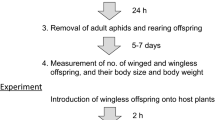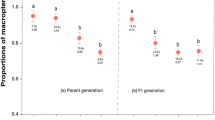Abstract
Natural enemies not only influence prey density but they can also cause the modification of traits in their victims. While such non-lethal effects can be very important for the dynamic and structure of prey populations, little is known about their interaction with the density-mediated effects of natural enemies. We investigated the relationship between predation rate, prey density and trait modification in two aphid-aphid predator interactions. Pea aphids (Acyrthosiphon pisum, Harris) have been shown to produce winged dispersal morphs in response to the presence of ladybirds or parasitoid natural enemies. This trait modification influences the ability of aphids to disperse and to colonise new habitats, and hence has a bearing on the population dynamics of the prey. In two experiments we examined wing induction in pea aphids as a function of the rate of predation when hoverfly larvae (Episyrphus balteatus) and lacewing larvae (Chrysoperla carnea) were allowed to forage in pea aphid colonies. Both hoverfly and lacewing larvae caused a significant increase in the percentage of winged morphs among offspring compared to control treatments, emphasising that wing induction in the presence of natural enemies is a general response in pea aphids. The percentage of winged offspring was, however, dependent on the rate of predation, with a small effect of predation on aphid wing induction at very high and very low predation rates, and a strong response of aphids at medium predation rates. Aphid wing induction was influenced by the interplay between predation rate and the resultant prey density. Our results suggests that density-mediated and trait-mediated effects of natural enemies are closely connected to each other and jointly determine the effect of natural enemies on prey population dynamics.




Similar content being viewed by others
References
Abrams PA (1995) Implications of dynamically variable traits for identifying, classifying, and measuring direct and indirect effects in ecological communities. Am Nat 146:112–134
Addicott JF (1978) The population dynamics of aphids on fireweed: a comparison of local populations and metapopulations. Can J Zool 56:2554–2564
Adler FR, Grunbaum D (1999) Evolution of forager responses to inducible defenses. In: Tollrian R, Harvell CD (eds) The ecology and evolution of inducible defenses. Princeton University Press, Princeton, N.J., pp 259–285
Bänsch R (1964) Vergleichende Untersuchungen zur Biologie und zum Beutefangverhalten aphidivorer Coccinelliden, Chrysopiden und Syrphiden. Zool Jb Syst 91:271–340
Chambers RJ (1988) Syrphidae. In: Minks AK, Harrewijn P (eds) Aphids, their biology, natural enemies and control, vol B. Elsevier, Amsterdam, pp 259–270
Clegg JM, Barlow CA (1982) Escape behaviour of the pea aphid Acyrthosiphon pisum (Harris) in response to alarm pheromone and vibration. Can J Zool 60:2245–2252
Diehl S, Cooper SD, Kratz KW, Nisbet RM, Roll SK, Wiseman SW, Jenkins TM (2000) Effects of multiple, predator-induced behaviors on short-term producer-grazer dynamics in open systems. Am Nat 156:293–313
Dixon AFG (1998) Aphid ecology. Chapman and Hall, London
Dixon AFG, Agarwala BK (1999) Ladybird-induced life history changes in aphids. Proc R Soc Lond B 266:1549–1553
Gries G (1986) Zum Beutefangverhalten der Schwebfliegenlarve Syrphus balteatus Deg. (Diptera, Syrphidae). J Appl Entomol 102:309–313
Hindayana D, Meyhöfer R, Scholz D, Hans-Michael Poehling H-M (2001) Intraguild predation among the hoverfly Episyrphus balteatus de Geer (Diptera: Syrphidae) and other aphidophagous predators. Biol Contr 20:236–246
Ives AR, Dobson AP (1987) Antipredator behaviour and the population dynamics of simple predator-prey systems. Am Nat 130:431–447
Kawada K (1987) Polymorphism and morph determination. In: Minks AK, Harrewijn P (eds) Aphids, their biology, natural enemies and control, vol A., Elsevier, Amsterdam, pp 299–314
Krivan V (1998) Effects of optimal antipredator behavior of prey on predator-prey dynamics: the role of refuges. Theor Pop Biol 53:131–142
Kusch J (1998) Long-term effects of inducible defense. Ecoscience 5:1–7
Lima SL (1998a) Nonlethal effects in the ecology of predator-prey interactions — what are the ecological effects of anti-predator decision-making? BioScience 48:25–34
Lima SL (1998b) Stress and decision making under the risk of predation: recent development from behavioral, reproductive, and ecological perspectives. Adv Study Behav 27:215–290
MacKay PA, Lamb RJ (1979) Migratory tendency in aging populations of the Pea Aphid, Acyrthosiphon pisum. Oecologia 39:301–308
MacKay PA, Wellington WG (1977) Maternal age as a source of variation in the ability of an aphid to produce dispersing forms. Res Popul Ecol 18:195–209
Meester L de, Dawidowicz P, van Gool E, Loose C (1998) Ecology and evolution of predator-induced behavior of zooplankton: depth selection behavior and diel vertical migration. In: Tollrian R, Harvell CD (eds) The ecology and evolution of inducible defenses. Princeton University Press, Princeton, N.J., pp 160–176
Montgomery ME, Nault LR (1977) Comparative response of aphids to the alarm pheromone, (E)-ß- farnesene. Entomol Exp Appl 22:236–242
Nakaoka M (2000) Nonlethal effects of predators on prey populations: predator-mediated change in bivalve growth. Ecology 81:1031–1045
Norrdahl K, Korpimäki E (2000) The impact of predation risk from small mustelids on prey populations. Mammal Rev 30:147–156
Peacor SD (2002) Positive effect of predators on prey growth rate through induced modifications of prey behaviour. Ecol Lett 5:77–85
Peacor SD, Werner EE (2001) The contribution of trait-mediated indirect effects to the net effects of a predator. Proc Natl Acad Sci USA 98:3904–3908
Peckarsky BL, Taylor BW, McIntosh AR, McPeek MA, Lytle DA (2001) Variation in mayfly size at metamorphosis as a developmental response to risk of predation. Ecology 82:740–757
Riessen HP (1999) Chaoborus predation and delayed reproduction in Daphnia: a demographic modeling approach. Evol Ecol 13:339–363
Roos AM de, Leonardsson K, Persson L, Mittelbach GG (2002) Ontogenetic niche shifts and flexible behavior in size-structured populations. Ecol Monogr 72:271–292
Ruxton GD, Lima SL (1997) Predator-induced breeding suppression and its consequences for predator-prey population dynamics. Proc R Soc Lond B 264:409–415
Schmitz OJ, Hamback PA, Beckerman AP (2000) Trophic cascades in terrestrial systems: A review of the effects of carnivore removals on plants. Am Nat 155:141–153
Sih A (1997) To hide or not to hide? Refuge use in a fluctuating environment. Trees 12:375–376
Sih A, Enlund G, Wooster D (1998) Emergent impacts of multiple predators on prey. Trees 13:350–355
Sloggett JJ, Weisser WW (2002) Parasitoids induce production of the dispersal morph in the pae aphid, Acyrthosiphon pisum. Oikos 98:323–333
Sloggett JJ, Weisser WW (2003) A general mechanism for predator- and parasitoid-induced dispersal in the pea aphid, Acyrthosiphon pisum (Harris). Proceedings of the 6th International Symposium on Aphids, in press
Sokal RR, Rohlf FJ (1987) Introduction to biostatistics, 2nd edn. Freeman, New York
Sutherland ORW (1969a) The role of crowding in the production of winged forms by two strains of the pea aphid, Acyrthosiphon pisum. J Insect Physiol 15:1385–1410
Sutherland ORW (1969b) The role of the host plant in the production of winged forms by two strains of the pea aphid Acyrthosiphon pisum. J Insect Physiol 15:2179–2201
Tollrian R (1995) Predator-induced morphological defenses—costs, life-history shifts, and maternal effects in Daphnia pulex. Ecology 76:1691–1705
Tollrian R, Harvell CD (1998) The ecology and evolution of inducible defences. Princeton University Press, Princeton, N.J.
Van Buskirk J, McCollum SA, Werner EE (1997) Natural selection for environmentally induced phenotypes in tadpoles. Evolution 51:1983–1992
Weisser WW (2000) Metapopulation dynamics in an aphid-parasitoid system. Entomol Exp Appl 97:83–92
Weisser WW, Braendle C (2001) Body colour and genetic variation in winged morph production in the pea aphid. Entomol Exp Appl 99:217–223
Weisser WW, Braendle C, Minoretti N (1999) Predator-induced morphological shift in the pea aphid. Proc R Soc Lond B 266:1175–1182
Wohlers P (1981) Effects of the alarm pheromone (E)- ß- farnesene on dispersal behaviour of the pea aphid Acyrthosiphon pisum. Entomol Exp Appl 29:117–124
Acknowledgements
We are very grateful to John Sloggett for elucidating discussions and for his comments to the manuscript. We would also like to thank Katz Biotech Services for donating E. balteatus and C. carnea, and Ingrid Jakobi for technical assistance. The study was supported by the state of Thuringia, Germany, under the grant scheme Graduiertenstipendium.
Author information
Authors and Affiliations
Corresponding author
Rights and permissions
About this article
Cite this article
Kunert, G., Weisser, W.W. The interplay between density- and trait-mediated effects in predator-prey interactions: a case study in aphid wing polymorphism. Oecologia 135, 304–312 (2003). https://doi.org/10.1007/s00442-003-1185-8
Received:
Accepted:
Published:
Issue Date:
DOI: https://doi.org/10.1007/s00442-003-1185-8




